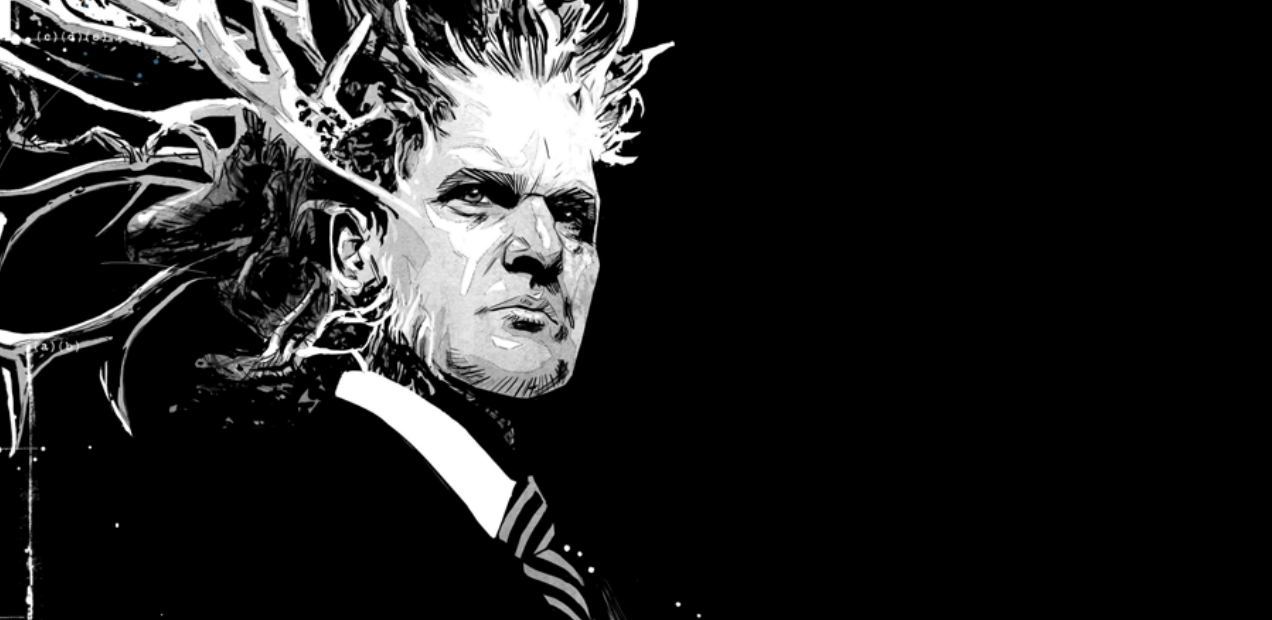
Cover to ‘The Black Monday Murders’ #6. Art by Tomm Coker/Image Comics
By Jarrod Jones. The Black Monday Murders is a horror show of the highest order. It’s sleek, sophisticated, shrewd in its telling, devastating with its subtext.
It’s dense, packed with family trees, timelines, secrets, shadows… yet it’s decidedly trim too. The Black Monday Murders is a story that knows what to show and when to show it — a virtue provided by Jonathan Hickman, a writer humbling us with his best work, possibly ever. But it also knows how to show it to us, what colors are necessary, which are not… which shadows obscure the monsters, which monsters are bathed in light. That’s something given to us by Tomm Coker and Michael Garland. I’ve never seen so much disquiet executed with such harmony.
The Black Monday Murders is a book that plays with misdirection as much as it does blatant truths, the latter of which we often find staring right back at us. It’s compulsively re-readable, a book that rewards vigilance while simultaneously damning us to a lifetime of devotion. All Hail God Mammon. Beware the Familiars. Beware the monstrous rule of the Rothschilds.
Hickman and Coker’s tale concerns itself with institutions, mostly of the financial and familial sort. Money worship. Fidelity. Sacrifice. Balance. Characters, like Detective Theodore Dumas and Dr. Tyler Gaddis (seen below), speak often of “infernal realms” and “demonic royalty” while the rest of the world moves and shifts around them, blissfully ignorant. They both want to know how the world works. Only one of them understands the consequences that come with challenging the principles at play. Says Dr. Gaddis: “It’s advantageous not to wake what slumbers.” Now try to sleep.
It’s a story that’s about as dark as they come, almost severe. Thankfully it can also be funny from time to time.
Detective Dumas and Dr. Gaddis are merely scratching the surface. The titanic evil that controls the world has been hard at work for centuries, perhaps even longer. Families with names like Rothschild and Bischoff and Ackermann populate the stories’ shifting timelines, colluding amongst themselves for generations and plotting against each other for just as long. God Mammon demands balance, but Grigoria Rothschild wants to burn it all to the ground.
“The scales between myself and Viktor are unbalanced — you know what that means,” Grigoria tells Beatrix Bischoff, just after putting a bullet through the head of her target. Bea certainly knows what that implies, though it’s perfectly fine if you don’t; Hickman stashes away the rules of the scales, both Greater and Lesser, in the appendices of this issue.
Those appendices have become a reader’s greatest asset. But like most things that can be quantified, counted on, or desperately needed — like most things that matter in the world — they can be abused. Let Hickman’s charts and glyphs tease you, but don’t let them haunt you. The real meat of The Black Monday Murders is inside its pages; its secrets prime for the slaughter.
It’s terrifying. Not just in a visceral sense — though it does enjoy getting messy from time to time. And it’s good that it frightens you. The alternative is to set it down. Let the evil lurk in the shadows. Let it stay there. By then The Black Monday Murders has already put its hooks into us. Altered the way we look at things. Thank Jonathan Hickman and Tomm Coker’s eerie metaphor about how the world works. Appreciate that the center will not hold. Fear what comes next.
Image Comics/$3.99
Written by Jonathan Hickman.
Art by Tomm Coker.
Colors by Michael Garland.
Letters by Rus Wooton.
9.5 out of 10













